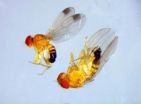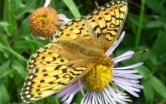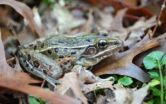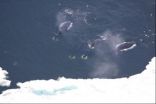Nano rescues skin
Shrimp shell nanotech for wound healing and anti-aging face cream
2012-03-19
(Press-News.org) Nanoparticles containing chitosan have been shown to have effective antimicrobial activity against Staphylococcus saprophyticus and Escherichia coli. The materials could be used as a protective wound-healing material to avoid opportunistic infection as well as working to facilitate wound healing.
Chitosan is a natural, non-toxic and biodegradable, polysaccharide readily obtained from chitin, the main component of the shells of shrimp, lobster and the beak of the octopus and squid. Its antimicrobial activity is well known and has been exploited in dentistry to prevent caries and as preservative applications in food packaging. It has even been tested as an additive for antimicrobial textiles used in clothing for healthcare and other workers.
Now, Mihaela Leonida of Fairleigh Dickinson University, in Teaneck, New Jersey and colleagues writing in the International Journal of Nano and Biomaterials describe how they have prepared nanoparticles of chitosan that could have potential in preventing infection in wounds as well as enhancing the wound-healing process itself by stimulating skin cell growth.
The team made their chitosan nanoparticles (CNP) using an ionic gelation process with sodium tripolyphosphate. This process involves the formation of bonds between polymers strands, a so-called cross-linking process. Conducted in these conditions it precludes the need for complex preparative chemistry or toxic solvents. CNP can also be made in the presence of copper and silver ions, known antimicrobial agents. The researchers' preliminary tests show the composite materials to have enhanced activity against two representative types of bacteria.
Understanding the mechanism of inhibition of bacteria by these particles may lead to the preparation of more effective antibacterial agents. The team has also demonstrated that the CNP have skin regenerative properties in tests on skin cell fibroblasts and keratinocytes, in the laboratory, which might even have implications for anti-aging skin care products.
INFORMATION:
"Nanocomposite materials with antimicrobial activity based on chitosan" in Int. J. Nano and Biomaterials, 2012, 3, 316-334
END
ELSE PRESS RELEASES FROM THIS DATE:
2012-03-19
New biotechnological and chemical methods will facilitate efficient production of chemicals, materials and fuels from renewable natural resources. The Academy of Finland Centre of Excellence (CoE) in White Biotechnology – Green Chemistry Research focuses on the research and development of microbial cells, or cell factories, for producing new useful compounds from sugars in plant biomass. These compounds can be used, for example, for manufacturing bioplastics or in medical applications.
"By means of gene technology, we can modify microbial metabolism and thereby produce ...
2012-03-19
Coming from the Asian continent, Drosophila suzukii has only been in Spain for a short time. Far away from slipping through into the Iberian Peninsula, it accelerated towards the north of Europe where it has already crossed the Alps. Amongst its preferred target are cherries and red fruits but any type of fruit is suitable for it to lay its eggs. This insect is posing a threat to the fruit of more and more European countries.
"Out of the 3,000 known species of Drosophilae, commonly named the vinegar fly, only two are potentially dangerous to fruit crops. One of them is ...
2012-03-19
Have you ever wondered how life is sustained in environments like deserts, deep seas or the polar regions? How do organisms adapt and thrive in such harsh conditions, and what challenges do they face as a result of human activities and climate change, especially climate "extremization"? Shedding light on some of these issues is the objective of the European Science Foundation's (ESF) session on 27 March at Planet Under Pressure 2012. The session will look at different aspects of life in extreme environments - from knowledge to sustainable exploitation of new resources under ...
2012-03-19
Montreal, March 16, 2012 – A clinical study co-led by the Montreal Heart Institute and Innovaderm Research Inc., which was presented today at the annual meeting of the American Academy of Dermatology, shows that a new treatment for psoriasis could be associated with a significant decrease in vascular inflammation, a major risk factor of cardiovascular disease.
Psoriasis is a chronic inflammatory disease of the skin and joints that affects up to 3% of the population. This disease is associated with a greater risk of heart attack (infarction) and stroke. The goal of this ...
2012-03-19
Early snowmelt caused by climate change in the Colorado Rocky Mountains snowballs into two chains of events: a decrease in the number of flowers, which, in turn, decreases available nectar. The result is decline in a population of the Mormon Fritillary butterfly, Speyeria mormonia.
Using long-term data on date of snowmelt, butterfly population sizes and flower numbers at the Rocky Mountain Biological Laboratory, Carol Boggs, a biologist at Stanford University, and colleagues uncovered multiple effects of early snowmelt on the growth rate of an insect population.
"Predicting ...
2012-03-19
In the wilds of New York City--or as wild as you can get that close to skyscrapers--scientists have found a new leopard frog species.
For years, biologists mistook it for a more widespread variety of leopard frog.
While biologists regularly discover new species in remote rainforests, finding this one in ponds and marshes--sometimes within view of the Statue of Liberty--is a big surprise, said scientists from the University of California, Los Angeles; Rutgers University; the University of California, Davis and the University of Alabama.
"For a new species to go unrecognized ...
2012-03-19
You've been feeling under the weather. You Google your symptoms. A half-hour later, you're convinced it's nothing serious—or afraid you have cancer. More than 60 percent of Americans get their health information online, and a majority of those decide whether to see a doctor based on what they find. "Wow, this is an era of self-diagnosis," thought Arizona State University psychologist Virginia Kwan, learning that statistic. How might information accessed online affect individual health decisions?
In a new study, Kwan and her colleagues found that the way information is ...
2012-03-19
TORONTO, ON—Scientists at the University of Toronto have found a molecular mechanism that plays a key role in the transition of Candida albicans yeast into disease-causing fungus—one of the leading causes of hospital-acquired infection. The finding highlights the importance of heat in fungal growth, and provides a new target for drug therapies to counter Candida albicans infection.
Candida albicans is a normally harmless yeast that is present in all humans. It becomes infectious in various genetic and environmental conditions, with temperature as a key determinant. It ...
2012-03-19
NEW YORK (March 16, 2012)—A rapid increase in shipping in the formerly ice-choked waterways of the Arctic poses a significant increase in risk to the region's marine mammals and the local communities that rely on them for food security and cultural identity, according to an Alaska Native groups and the Wildlife Conservation Society who convened at a recent workshop.
The workshop—which ran from March 12-14—examined the potential impacts to the region's wildlife and highlighted priorities for future management of shipping in the region. The meeting included participants ...
2012-03-19
Glacial meltwater increases biodiversity in mountainous freshwater ecosystems. As glaciers vanish due to global warming, so will those species dependent upon the icy runoff. This is the conclusion of a study authored by researchers from, among other institutions, the University of Copenhagen.
The article "Glacial river biodiversity" with the alarming new findings can be found in the journal Nature Climate Change.
"The knowledge is new and startling. Glacial runoff is cold, nutrient-poor and physically unstable, and therefore, typically species-poor. Traditionally, we ...
LAST 30 PRESS RELEASES:
[Press-News.org] Nano rescues skin
Shrimp shell nanotech for wound healing and anti-aging face cream



